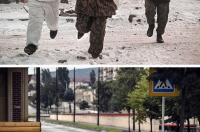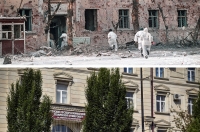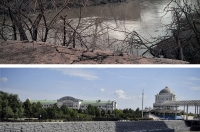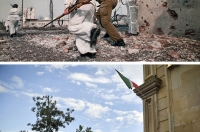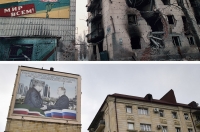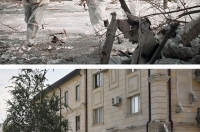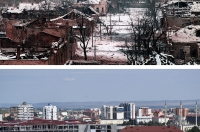The memories Chechnya holds
Grozny, Russia -- I really didn’t want to go on this trip. It was pretty clear that we were there to provide advertising for Chechen authorities -- to take pictures of the supposedly booming tourism sector of the Russian republic where separatists fought two wars against Moscow since the Soviet Union collapsed in 1991 and that has been under the iron grip of a son of a separatist-turned-Kremlin ally since 2004.
As usual, the Western press was enticed to go with a promise that we would get to interview the son, Ramzan Kadyrov, who assumed control over Chechnya after his father was killed in a bombing. Ramzan Kadyrov came to power when much of Chechnya, especially its capital Grozny, lay destroyed from the second war with Moscow troops. Since then, it has been rebuilt, but human rights groups accuse Kadyrov of running a ruthless fiefdom, with arbitrary detentions, murders, kidnappings and widespread rights violations. He doesn’t often talk to the press, so the promise of an interview is always appealing.
So I went.
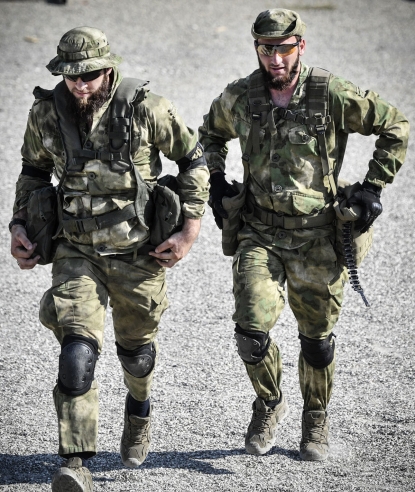 Chechen special force troops attend a training session in the Chechen town of Gudermes, July 25, 2019. (AFP / Alexander Nemenov)
Chechen special force troops attend a training session in the Chechen town of Gudermes, July 25, 2019. (AFP / Alexander Nemenov) A Chechen special force trooper trooper with a patch reading "advanced PK user." The saying refers to the PK Kalashnikov machine gun and is also a play on words of a popular phrase that describes someone's computer skills and that is often included on Russian resumes (PC translates into PK in Russian). Gudermes, Chechnya, July 25, 2019. (AFP / Alexander Nemenov)
A Chechen special force trooper trooper with a patch reading "advanced PK user." The saying refers to the PK Kalashnikov machine gun and is also a play on words of a popular phrase that describes someone's computer skills and that is often included on Russian resumes (PC translates into PK in Russian). Gudermes, Chechnya, July 25, 2019. (AFP / Alexander Nemenov)
I hadn’t properly visited Grozny in 25 years, when the first Chechen war was raging and we roamed the city at will and at our own risk. Afterward, I had come on a few Kremlin-organized trips, but we only saw the city from bus windows.
I was determined to get something useful out of this trip and decided that whatever happens, I would try to visit the places where I was running around with Chechen fighters in the winter of 1994-1995. To see how things have changed.
The plane landed at the “Severny” (Northern) airport, the very same one that 25 years ago was a portal between two worlds, war and peace. Scenes from the past washed over me like a flood.
 People walk towards the airport of Grozny on July 24, 2019. (AFP / Alexander Nemenov)
People walk towards the airport of Grozny on July 24, 2019. (AFP / Alexander Nemenov)Summer 95...Wounded Russian soldiers, in their underwear and with crutches, hobbling across a field to a plane that will take them away from here, to their loved ones. Away from the fire, blood and dirt.
August 96… Boy soldiers who threw up all over the landing strip near a helicopter as they unloaded the bodies of their friends, which had started to decompose after lying in the hot summer sun for a few days.
March 96…. The month that separatist commander Ruslan Gelayev and his troops took the city from the Russians. I ended up taking the last civilian flight to Grozny from Moscow, there weren’t any for ages afterward... Russian police troops known as OMON forbade us to leave the airport; they wanted to put us back on a plane and send it back to Moscow, since Grozny was in full-out war and separatists controlled much of the city. But most of the passengers were locals who refused to leave. They broke through the police cordon and ran out of the airport. I mixed in with them. Spent the night with a guy I knew. The next morning he took me to Gelayev’s troops.
April 95…. OMON servicemen can’t take their eyes off the helicopter window as it lifts them away from the city toward home. There is no mistaking the sentiment in their eyes -- never again to return to this city. Their fight is over.
 Russian police troops look out at Grozny as a plane takes them away from Chechnya's capital at the end of their tour of duty. April, 1995. (Photo courtesy of Alexander Nemenov)
Russian police troops look out at Grozny as a plane takes them away from Chechnya's capital at the end of their tour of duty. April, 1995. (Photo courtesy of Alexander Nemenov)Hot Chechen summer air rushed in as the plane doors opened, bringing me back to the present.
The highway to Grozny was adorned with photos of Russian President Vladimir Putin and Akhmat Kadyrov, Ramzan’s father.
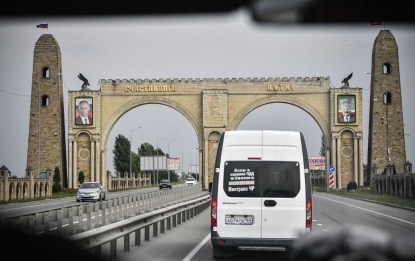 A road arch wishing Good Luck shows portraits of Russian President Vladimir Putin (L) and former Chechen president Akhmad Kadyrov, the father of the current Chechen leader Ramzan Kadyrov, in Grozny on July 24, 2019. (AFP / Alexander Nemenov)
A road arch wishing Good Luck shows portraits of Russian President Vladimir Putin (L) and former Chechen president Akhmad Kadyrov, the father of the current Chechen leader Ramzan Kadyrov, in Grozny on July 24, 2019. (AFP / Alexander Nemenov)A prominent separatist fighter during the first Chechen war, he served as chief mufti of independent Chechnya in the following years. But when the second war broke out in 2000, he switched sides, offering his support to Putin. He was killed on May 9, 2004 at a stadium in Grozny when a huge bomb placed under VIP seating exploded. Most of us journalists from back then remember that day for another reason, as the bombing killed Reuters photographer Adlan Khasanov, a larger-than-life figure who was the life of the party wherever he went and a beloved member of the foreign agency press corps here.
We were taken to a ritzy hotel, the best in Grozny and the permanent home of the local football club Terek.
 A Chechen policeman guards in front of the "Heart of Chechnya - Akhmat Kadyrov Mosque" in Grozny on July 26, 2019. (AFP / Alexander Nemenov)
A Chechen policeman guards in front of the "Heart of Chechnya - Akhmat Kadyrov Mosque" in Grozny on July 26, 2019. (AFP / Alexander Nemenov)The following day I told the Moscow minders accompanying us that instead of going to the regional town of Vedeno as planned, I preferred to take a walk through the places that I remembered from the past. Outraged, they told me that this was out of the question -- the locals wouldn’t understand and you could then forget about the interview with Kadyrov. So to Vedeno I went.
The town and the surroundings are the birthplace of Shamil Basayev, a radical separatist leader who was also behind some of the most horrific hostage-takings in Russia, including the Beslan school massacre in 2004 and the Moscow Nord-Ost theater in 2002. This region is in the mountains of Chechnya, where during the first war the separatists fought fierce battles against Russian forces. Today there is a yacht club here at a local lake, which is where our minders brought us.
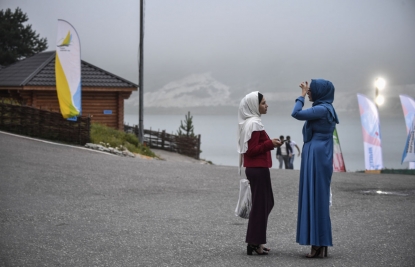 Chechen women talk to each other at Kazenoy yachting club in Chechnya's Vedeno district on July 24, 2019. (AFP / Alexander Nemenov)
Chechen women talk to each other at Kazenoy yachting club in Chechnya's Vedeno district on July 24, 2019. (AFP / Alexander Nemenov)To get there, we drove along a road in a narrow valley. It reminded me of the western end of the Panjshir in Afghanistan, where it leads into the Charikar Valley. I remembered how during the first war a Russian major once said as we passed through here “Look at how beautiful this is. Almost Switzerland.”
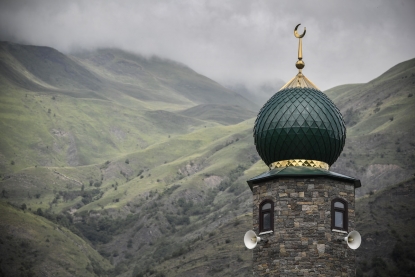 A minaret is seen outside the village of Gukhoy in Itum Kale district of Chechnya on July 25, 2019. (AFP / Alexander Nemenov)
A minaret is seen outside the village of Gukhoy in Itum Kale district of Chechnya on July 25, 2019. (AFP / Alexander Nemenov) A Chechen tribal tower is seen in the settlement of Kharachoy in Chechnya's Vedeno district on July 24, 2019. (AFP / Alexander Nemenov)
A Chechen tribal tower is seen in the settlement of Kharachoy in Chechnya's Vedeno district on July 24, 2019. (AFP / Alexander Nemenov)
“Let’s hope that the “Swiss” don’t come down from the mountains just now,” deadpanned one of his colleagues, referring to the Chechen rebels hiding in the beautiful landscape.
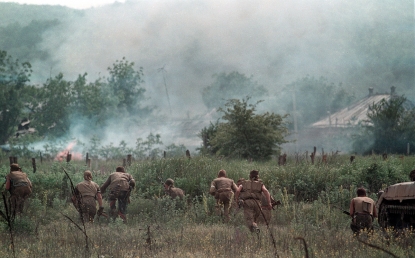 Russian soldiers launch an attack on the Chechen village of Bamut, May 24, 1996. (Photo courtesy of Alexander Nemenov)
Russian soldiers launch an attack on the Chechen village of Bamut, May 24, 1996. (Photo courtesy of Alexander Nemenov)The interview with Ramzan didn’t materialize the next day, so we were driven to an even further spot in the mountains, Itum-Kale, the site of Chechnya’s ski resort. We were shown all the nooks and crannies of this alpine gem, all the while being assured that it will soon be better than any ski resort in the Alps. “Really, when?” was all I could think as I glanced around.
Our trip lasted four days and on the evening of the third I still hadn’t gotten to do what I came for. I had only one remaining chance, the morning of our last day in the city. We were due to fly home in the afternoon.
I got up at 6:00 am and walked out of the hotel, full of thoughts about where I was going to go and what I was going to see. I planned on going to what was always known as “Minutka ("Quick Minute") Square" (according to one version, it was so called because during Soviet times, a bus stopped for a minute here to pick up workers going to a nearby factory), across the River Sunzha, near the place where there once stood the presidential palace, then to People’s Friendship Square, where there still stands a monument of three men, a Russian, a Chechen and an Ingush.
This square was always called “The Three Fools Monument.” In between the wars with Russia, when Chechnya came under jihadists’ influence, public executions were held here.
 Downtown Grozny from a Chechen front line, January 25, 1995. (AFP / Alexander Nemenov)
Downtown Grozny from a Chechen front line, January 25, 1995. (AFP / Alexander Nemenov) Same spot, July 26, 2019. (AFP / Alexander Nemenov)
Same spot, July 26, 2019. (AFP / Alexander Nemenov)
Walking briskly in the cool morning breeze, I quickly reached Minutka. A young brother and sister were crossing the street. The boy carefully looked to make sure no cars were coming. Twenty five years ago, I saw a group of rebels in this spot, running from house to house, holding a nurse by the hand as they helped lead her to shelter from gunfire. She wore a soldier’s helmet and a huge soldier’s overcoat.
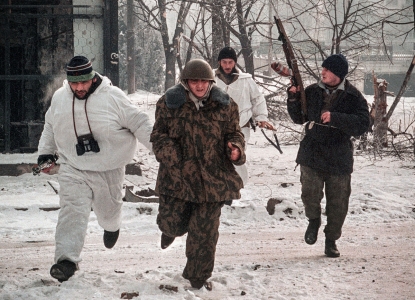 A group of Chechen rebels helps a paramedic cross a street to reach shelter from Russian gunfire during fights in downtown Grozny, January 25, 1995. (AFP / Alexander Nemenov)
A group of Chechen rebels helps a paramedic cross a street to reach shelter from Russian gunfire during fights in downtown Grozny, January 25, 1995. (AFP / Alexander Nemenov) A brother and sister cross the same street in Grozny, July 26, 2019. (AFP / Alexander Nemenov)
A brother and sister cross the same street in Grozny, July 26, 2019. (AFP / Alexander Nemenov)
As I stood on the square, something inside clicked and I found myself back there… in the winter of 1994-95.
Grozny, late December 1994, just before Russian troops came into the city. During the nights, the entire city seems to be on fire. People are always running somewhere. Sacks, sleds, old women, children… It’s cold and dark and damp. Fear is everywhere… you get so scared at times it nearly makes you sick. Everyone is saying that the Russians will smash their way into the city at any minute now. First they’ll turn off the electricity and then they’ll kill everyone. For some reason everyone is referring to them as “combat swimmers.” Why swimmers? Who knows. Rumors have no rhyme or reason.
Each morning -- fresh snow, trails of footprints snaking through, the smell of burning so strong that it tickles the nose… and silence. The mornings after nighttime raids are so quiet. Cars dot the streets, the bodies inside covered with sheets. All under a blanket of fog.
 Victory Boulevard in central Grozny, February 1, 1995. (AFP / Vladimir Mashatin)
Victory Boulevard in central Grozny, February 1, 1995. (AFP / Vladimir Mashatin)One evening, a buddy of mine, Tolya Morkovkin and I were looking for a place to spend the night. We both worked for TASS at the time and freelancing for Western media outlets. We found a hotel in the center of the city. It was dark by then and you could hear the unmistakable sound of approaching warplanes. You have to live through just one bombing for that sound to stir up dread. Because you know what’s coming.
It didn’t take long -- explosions went off here and there. The fog was particularly thick that night. With the explosions, it was like a red glow creeping over the city. We ran to the “Detskii Mir” (Children’s World) department store. Right then, a bomb hit a nearby building. Firefighters appeared, by habit I suppose. They tried to put out the flames. They worked tirelessley until exhaustion, then finally gave up and left.
Tolya and I went to our hotel. Two nearby buildings were already ablaze. Inside the hotel, two old ladies, white with fear. They gave us sheets, towels, took our money, wrote out a receipt. A somewhat surreal scene as warplanes whirr above and explosions go off here and there.
Except for us, the hotel was empty. For some reason, they put us on the top floor of the five-story building. Smack in the middle of the bombing. We had dinner -- two Snickers bars and half a bottle of vodka. Tried to fall asleep, but couldn’t. It’s scary when the explosions get closer and closer. We finished the bottle and went down to the first floor, to hide under the stairs with the two old women.
The two old ladies were gulping down valerian root extract (a mild sedative sometimes known as “nature’s Valium” that’s very popular in Russia for ‘nerves’) -- like had chugged our vodka. Tolya and I didn’t have anything left to gulp down, so we just sat there silently, freezing our butts off. The cold and the need for sleep eventually won out over the fear, so after a while, we just went upstairs and fell asleep.
 An oil refinery burns in Grozny as a Russian helicopter fires a flare to deflect any anti-aircraft fire from the ground, August, 1996. (Photo courtesy of Alexander Nemenov)
An oil refinery burns in Grozny as a Russian helicopter fires a flare to deflect any anti-aircraft fire from the ground, August, 1996. (Photo courtesy of Alexander Nemenov)With that, I snapped out of my flashbacks and headed toward the city center. Eventually I reached a wide crossroads. I remember how scary it used to be to cross it, under mortar fire. It was Lenin Avenue back then. Today it’s Akhmat Kadyrov Avenue.
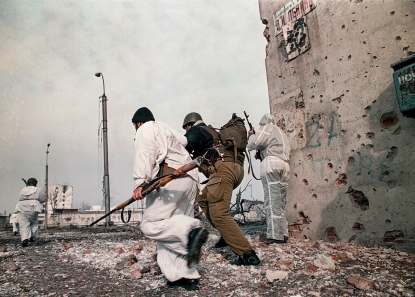 Chechen fighters under Russian fire run along Lenin Avenue in Grozny, January 25, 1995.
(AFP / Alexander Nemenov)
Chechen fighters under Russian fire run along Lenin Avenue in Grozny, January 25, 1995.
(AFP / Alexander Nemenov)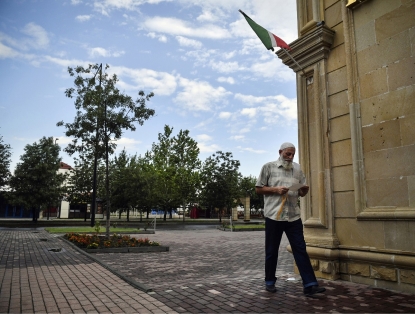 Same spot, now known as Akhmat Kadyrov Avenue, July 26, 2019.
(AFP / Alexander Nemenov)
Same spot, now known as Akhmat Kadyrov Avenue, July 26, 2019.
(AFP / Alexander Nemenov)
A little way down the road I saw a huge poster of Putin and Kadyrov St on a building. Twenty-five years ago, the building was adorned with another poster, with white doves and a proclamation “Peace to the Caucasus! Peace to all!”
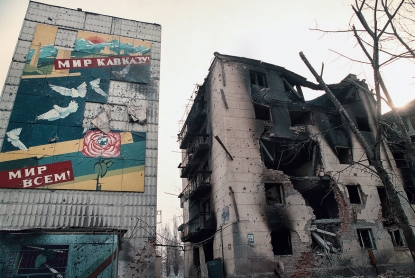 "Peace to the Caucasus! Peace to all!" reads a sign on a building in Grozny, January 25, 1995.
(AFP / Alexander Nemenov)
"Peace to the Caucasus! Peace to all!" reads a sign on a building in Grozny, January 25, 1995.
(AFP / Alexander Nemenov) A building on the same spot on July 26, 2019, features a poster showing Russian President Vladimir Putin and former Chechen president Akhmat Kadyrov.
(AFP / Alexander Nemenov)
A building on the same spot on July 26, 2019, features a poster showing Russian President Vladimir Putin and former Chechen president Akhmat Kadyrov.
(AFP / Alexander Nemenov)
January 1994 -- The day after the bombing, Tolya and I left our hotel in one piece. Fresh fallen snow had covered up all the dirt and whatever had burned up in the bombings overnight. No-one was around. Just us and the footprints we were making in that fresh snow. We were walking along, thinking of how to get a car, to start heading back to Moscow. We started talking about all the nice things we’d do there, where there’s no war.
All of a sudden five Chechen fighters appeared out of nowhere. Dressed in white, with machine guns slung over their shoulders, these guys were serious. Walking along the other side of the street, to the same crossroads that we were. Like two fates colliding. Today the scene seems funny.
“Hey, where are you coming from? Where are you heading?”
“We’re foreign journalists, photographers,” we answer. I took out my pass for an international agency that I was freelancing for at the time, Tolya took out a pass from a French newspaper. Press passes from TASS, the Russian news agency, didn’t seem like the best thing to show to these fellas.
The guys talked among themselves in Chechen. Then one of them turned to us and said:
“Where are your second IDs?”
“What second IDs?” we asked, as our hearts dropped.
“What second IDs,” he repeated mockingly. “You trying to make foolish out of us? Your FSK (how the FSB was called back then) IDs. Take everything out of your backpacks! Now!”
We’re screwed, I thought as I gingerly took out my things. If they find the TASS ID’s, we’re never going to be able to convince them that we’re just journalists, it’ll be useless.
“Find their radios!” barked our tormentor. “Correctors! They’re the ones who were correcting the coordinates for places to bomb all night!”
My heart dropped some more. These boys, though, didn’t excel at searching and didn’t find our TASS press passes. Thank God.
“We should just shoot you right here and now,” one of the guys said. “We know who you are. But just in case we’re wrong -- you never know -- we don’t want to have this on our conscience. Get the hell out of here.”
Back then, at war, the rebels still behaved with decency. That was to soon change. They didn’t have to ask twice. We picked up our things and off we went, on legs still wobbling from fear.
Oh, and the hotel...That got destroyed a few days later. Don’t know what happened to the two old ladies.
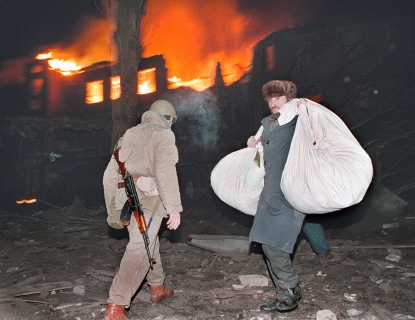 A man carries makeshift sacks containing his belongings from a burning building in Grozny, December 22, 1994. (Photo courtesy of Alexander Nemenov)
A man carries makeshift sacks containing his belongings from a burning building in Grozny, December 22, 1994. (Photo courtesy of Alexander Nemenov)Walking further I saw a building where in ‘95 we hid with the rebels who were dragging that nurse with them. Today it’s the Grozny Oil Technical University. Home to young students who have no idea that 25 years ago, this building was pockmarked with bullets and shrapnel, almost like the buildings in Stalingrad after the battle. That’s the comparison that popped into my mind back then.
Finally I got to the river. Sunzha. Before, its muddy waters would carry the bodies of those killed. You’d see the reflection of trees mutilated by the war on the surface. Today the reflection is of a ritzy hotel, its glass walls gleaming.
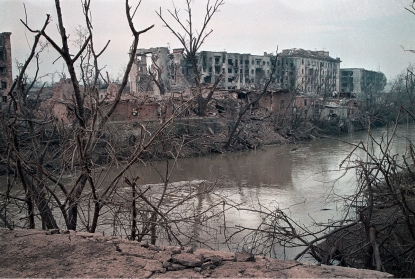 River Sunzha, Grozny, March 31, 1995.
(AFP / Alexander Nemenov)
River Sunzha, Grozny, March 31, 1995.
(AFP / Alexander Nemenov) Same spot, July 26, 2019. (AFP / Alexander Nemenov)
Same spot, July 26, 2019. (AFP / Alexander Nemenov)
The square where there was once the presidential palace was now gone. There was a monument to the “victims of terrorism” and a new mall being built behind the fence. And that’s it. As if it never even existed.
 Chechens walk in front of the destroyed presidential palace in Grozny, February, 1996.
(AFP / Alexander Nemenov)
Chechens walk in front of the destroyed presidential palace in Grozny, February, 1996.
(AFP / Alexander Nemenov)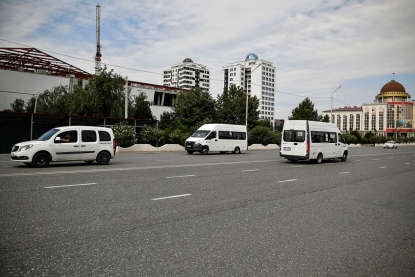 Where the presidential palace once stood, Grozny, July 26, 2019.
(AFP / Alexander Nemenov)
Where the presidential palace once stood, Grozny, July 26, 2019.
(AFP / Alexander Nemenov)The city’s main street was now V.V. Putin Avenue. Before, it was Victory Avenue. Not sure how the locals felt about naming the city’s main avenue after the man who bombed them. They didn’t like to discuss it. Too afraid.
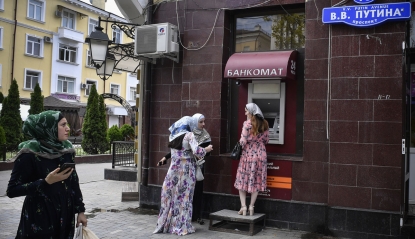 Chechen women wait in front of an ATM machine on Vladimir Putin Avenue (formerly Victory Avenue) in Grozny, July 26, 2019. (AFP / Alexander Nemenov)
Chechen women wait in front of an ATM machine on Vladimir Putin Avenue (formerly Victory Avenue) in Grozny, July 26, 2019. (AFP / Alexander Nemenov)Grozny, late January, 1995. I forget what part of town we were in. Once again it’s me and Tolya Morkovkin. We wanted to cross the dike in the river. Problem is that whatever appeared on the dike attracted fire from a nearby tank. So we went across, playing our version of Russian roulette. Got lucky and made it. There wasn’t much to take pictures of. The war was everywhere, but insofar as photos go, there was nothing great. And then, suddenly, a group of rebels appeared, pushing an anti-tank gun, wearing white coveralls. Couldn’t ask for a better picture.
They pushed the gun to a cliff and began to aim it at something. At first they tried to shoo us away, but then gave up. “Where did you get this,” I asked. “Took it from the Russians!” “What are you going to do with it?” “We’re going to aim it at the OMON guys (Russian special forces), right below us, by the river.”
The OMON guys are gonners, I think to myself. The rebels sat in a circle around the gun, there were about six of them, as they prepared the machine to fire. Tolya and I were about 10 meters away, sitting near a brick garage wall.
“Allahu Akbar! Fire!”
One of them pulled the cord. Bam! I got a fistful of dirt in my face. Something hit the wall a meter above our heads, and the bricks started falling. Smoke was everywhere, you couldn’t see a thing. My throat itched from all the dust and you couldn’t hear anything from the din in the ears.
When the smoke cleared up, I took in the following scene. The Chechens who had sat in a cirlce around the gun were now lying around it in the same geographical pattern, just now they held their knees to their chins. What choreography, I thought for some reason. After a few seconds, they all began to move, then to get up and shake the dirt off.
I still don’t know what happened. Either the Russians filled the gun with sand before abandoning it, or something misfired. The amazing thing was that no-one had so much as a scratch on them. We all just lost our hearing for a bit. The piece of metal that I still carry on my keychain is a part of that gun. It landed 300 meters away from the explosion and some locals later gave it to me as a gift. It took me forever to drill a hole through it.
Graphic image
 A Russian soldier looks at bodies of civilians at the Orthodox cemetery in Grozny, March 31, 1995. The bodies were exhumed from various places they were buried in the city and brought to the cemetery to be laid to rest. (Photo courtesy of Alexander Nemenov)
A Russian soldier looks at bodies of civilians at the Orthodox cemetery in Grozny, March 31, 1995. The bodies were exhumed from various places they were buried in the city and brought to the cemetery to be laid to rest. (Photo courtesy of Alexander Nemenov)
Eventually I got to the Square of the Three Idiots. I kept thinking of the night before, when our minders took us to the river to watch a beautiful light and music show on fountains. I was ill at ease. I kept looking at the faces of the young boys and girls who were there. They were happy and seemed without a care in the world, like all young people everywhere. Most of them probably had no idea what took place on this very same spot twenty five years ago. But I knew.
 A bridge over the Sunzha, downtown Grozny, March 31, 1995. (AFP / Alexander Nemenov)
A bridge over the Sunzha, downtown Grozny, March 31, 1995. (AFP / Alexander Nemenov)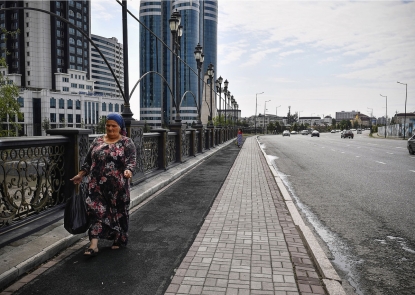 Same spot, July 26, 2019. (AFP / Alexander Nemenov)
Same spot, July 26, 2019. (AFP / Alexander Nemenov)
When I used to travel a lot to conflict zones for work, there was this special feeling that I would have when I got home. It was like I wasn't totally there. On the one hand, you’re home, on the other, your mind is still there, on the battlefield. It was always hard to get used to the fact that at home, there are nuances. And all you wanted was a simple answer to a simple question.
My loved ones have often accused me of liking war too much. It’s not that I like war, only a complete moron could actually like war. I like how people are in war.
 Chechen fighters carry their wounded friend out of a stream, Grozny, December 24, 1994. (Photo courtesy of Alexander Nemenov)
Chechen fighters carry their wounded friend out of a stream, Grozny, December 24, 1994. (Photo courtesy of Alexander Nemenov)I still remember so many people I met only briefly in the various wars I've covered. I may not remember their names, but their eyes and snippets of what they said remain. The words were always so simple and clear.
I remember….
...The Chechens who hid us, Russians, from Russian air raids during that scary winter of 94-95.
...The old Armenian in Nagorno-Karabakh, who shared his last, simple food with us, regaling us with stories and lessons about life, with a glass of “tutovka,” the local vodka. The kerosene lamp that lit his face, the huge stars in the black mountain sky somewhere around Gadrut.
...The young Azerbaijani lieutenant Elshan Bagirov, who had just finished the Soviet military academy and who returned home to Agdam to fight for his homeland.
...The Chechen women in a Grozny basement on March 8, 1996, Women’s Day and a huge deal for years in the Soviet Union. We all rolled into that basement to hide from the sniper fire above. “Ladies, Happy March 8th to you!” I announced. They all started crying. “We completely forgot! Thank you! Here, have something to eat!”
...The dashing Abkhaz guys, fuelled by wine and mandarins (it was mandarin season and we ate so many of them that I still think of Abkhazia every time I eat one) with their never-ending toasts…
...A middle-aged Afghan, with his flawless Russian, the head of the helicopter landing pad in Panjshir Valley who absolutely for free, like a brother, took me on board a helicopter in Dushanbe in 2001. How he and I drank that night, how he gave me his bed and slept outside...
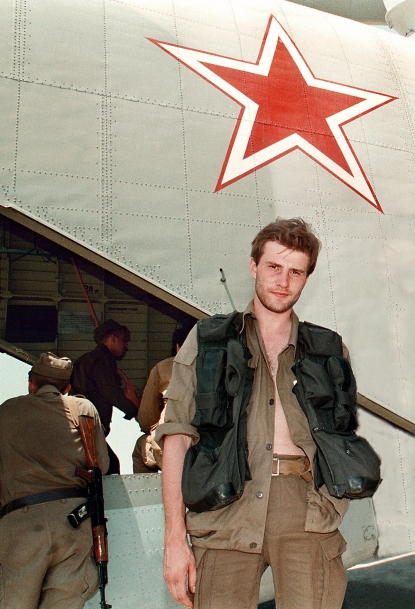 The author during a tour in Chechnya, August, 1995. (AFP / Alexander Nemenov)
The author during a tour in Chechnya, August, 1995. (AFP / Alexander Nemenov)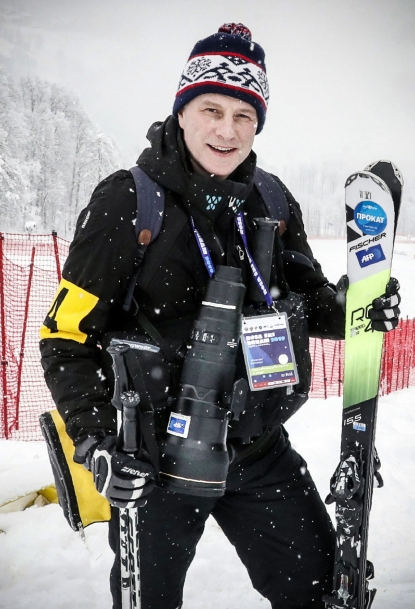 The author 25 years later, covering the Skiing World Cup in Sochi, Russia, March, 2019. (Photo courtesy of Alexander Nemenov)
The author 25 years later, covering the Skiing World Cup in Sochi, Russia, March, 2019. (Photo courtesy of Alexander Nemenov)
The interview with Ramzan Kadyrov never happened. It probably was never even an option. Аs always. But I’m glad I made the trip.
This blog was written with Yana Dlugy in Paris.
